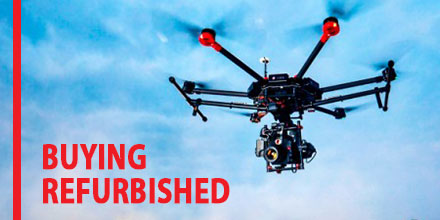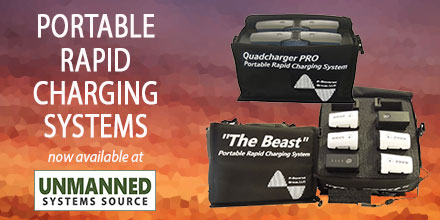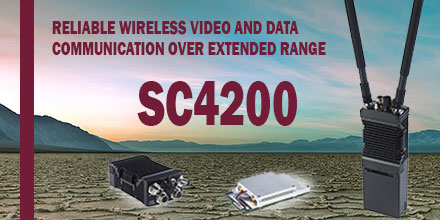19Sep
Refurbished Drones: considerations before you buy
 Smart phones, game consoles, smart TVs...and now, drones.
New technology is exciting but the cost of owning the latest gadgets prevent many from immediately running out and buying it. Many wait months before purchasing coveted products in the hopes that competition may eventually drive the price down.
However, some savvy shoppers choose another path...refurbished products.
From smartphones games consoles, refurbished electronics are a viable option for price-conscious consumers. Refurbished products offer consumers the chance to buy updated technology at a reduced price. However, when considering refurbished gadgets, a little due diligence is required.
Smart phones, game consoles, smart TVs...and now, drones.
New technology is exciting but the cost of owning the latest gadgets prevent many from immediately running out and buying it. Many wait months before purchasing coveted products in the hopes that competition may eventually drive the price down.
However, some savvy shoppers choose another path...refurbished products.
From smartphones games consoles, refurbished electronics are a viable option for price-conscious consumers. Refurbished products offer consumers the chance to buy updated technology at a reduced price. However, when considering refurbished gadgets, a little due diligence is required.
An affordable way to keep pace
Technological innovation happens at a break-neck pace. Products are updated regularly and newer models are quickly made available. And, as manufacturers look to ever increase revenue, product cycles seem to get shorter and shorter. It is easy to see how consumers are out-matched. Refurbished products come from a variety of sources, including: ex-display items, items with slight defects from shipping, and previously owned items - to name a few. A refurbished product can have either some or all of its components replaced with newer ones. Some are done by the manufacturer. Others by private individuals or companies that specialize in the product line in question.Types of refurbished drones
Just like many other types of electronics, refurbished drones are the result of the consumerist economy we live in. Here’s a quick look at the aforementioned causes behind refurbished electronics and their advantages or drawbacks, if any:- Drones with Defects: Manufacturers take every precaution to ensure products reach the customer in full functioning condition. However, issues do arise from time to time. If a drone is found to have a defects it is usually returned to the manufacturer for repairs. In some cases purchasing a refurbished drone in this instance is an advantage. This is due to the detailed inspection, repairs and testing which are carried out by experienced and certified technicians.
- Ex-Display Drones: Many retail shops display working prototypes so customers can examine and even demo the product. As such, demo drones are virtually new. Some stores make minor repairs to the item, if needed, and then offer it at a reduced priced. For those who don't mind a drone that's been handled a bit, it's an affordable option.
- Shipping Damaged Drones: Getting the product from the factory to the end-user often involves transport via several carriers. As such, it is not unusual for some product to get damaged en route. When this occurs, the drone is sent back to the factory for repairs or resold as-is at a lower price.
- Used Drones: Customers can change their mind and return a drone for numerous reasons, including: cost, a desire to upgrade, or personal preference. Such items are checked thoroughly before being offered for sale again, often at a lower price. This is a great way to own an almost-new drone at a fraction of the cost.

 High-precision GPS receivers mounted on drones able to identify 1mm hairline defects in cooling towers
High-precision GPS receivers mounted on drones able to identify 1mm hairline defects in cooling towers
 The power to extend flight time while in the field just got a little easier thanks to Colorado Drone Chargers.
Formerly known as P-Squared Group, Colorado Drone Chargers is a leading designer and manufacturer of rapid charging systems for unmanned aerial vehicles.
The company focuses exclusively on charging technology and ease of use for the customer.
The complete line of Portable Rapid Charging Systems (PRCS) is now available at Unmanned Systems Source.
“Our mission is to make and market the best products,” said Johnny Podrovitz, founder of Colorado Drone Chargers. “From day one, we have been committed to delivering exceptional products for the drone battery charging industry.”
The power to extend flight time while in the field just got a little easier thanks to Colorado Drone Chargers.
Formerly known as P-Squared Group, Colorado Drone Chargers is a leading designer and manufacturer of rapid charging systems for unmanned aerial vehicles.
The company focuses exclusively on charging technology and ease of use for the customer.
The complete line of Portable Rapid Charging Systems (PRCS) is now available at Unmanned Systems Source.
“Our mission is to make and market the best products,” said Johnny Podrovitz, founder of Colorado Drone Chargers. “From day one, we have been committed to delivering exceptional products for the drone battery charging industry.”
 NuWaves Engineering announced the completion of the IRaD phase for their newest miniaturized 10 watt C-band bidirectional amplifier (BDA). This product adds to the existing line of NuPower Xtender bidirectional amplifiers.
Currently, plans are to price this at $2,900/ea in quantities of one hundred. It is available Q4 2017. NuWaves is an international Radio Frequency (RF) and Microwave solutions provider.
NuWaves continues to push their presence and expertise to higher-frequency applications. The NuPower Xtender C10RX01 and C10RX02 BDA modules follow the release of the 20 W C-Band Power Amplifier (C20R01) and the 20 W C-Band bidirectional amplifier (C20RX01).
This latest BDA offers the performance of a traditional power amplifier coupled with a low noise amplifier for receive mode. It provides an amplification solution in one miniaturized package for half-duplex transceivers.
NuWaves Engineering announced the completion of the IRaD phase for their newest miniaturized 10 watt C-band bidirectional amplifier (BDA). This product adds to the existing line of NuPower Xtender bidirectional amplifiers.
Currently, plans are to price this at $2,900/ea in quantities of one hundred. It is available Q4 2017. NuWaves is an international Radio Frequency (RF) and Microwave solutions provider.
NuWaves continues to push their presence and expertise to higher-frequency applications. The NuPower Xtender C10RX01 and C10RX02 BDA modules follow the release of the 20 W C-Band Power Amplifier (C20R01) and the 20 W C-Band bidirectional amplifier (C20RX01).
This latest BDA offers the performance of a traditional power amplifier coupled with a low noise amplifier for receive mode. It provides an amplification solution in one miniaturized package for half-duplex transceivers.
 The StreamCaster 4200 (SC4200) radio by Silvus Technologies was recently selected by MILREM, a manufacturer of Unmanned Ground Vehicles (UGV) based in Estonia. MILREM will integrate the SC4200 onto the Tracked Hybrid Modular Infantry System (THeMIS) platform.
THeMIS UGV is an intelligence, surveillance and reconnaissance (ISR) platform. It assists with target acquisition, logistics support, and other missions.
The SC4200 serves as the datalink, providing wireless command/control and video. It pairs with high performance antennas to allow the THeMIS to drive extended ranges, and push video and data communication farther than before.
“Silvus is offering rugged and high quality MIMO radios which have proven to provide reliable wireless video and data communication over extended range,” said Rivo Opik, MILREM’s Chief Engineer. “The technical support and guidance from the Silvus team has been quick and very effective.”
SC4200 2x2 MIMO radio features transmit beamforming which nearly doubles the signal range. The ability to significantly extend range is why MILREM choose the SC4200 for the THeMIS. Companies purchasing the THeMIS can control, one, two or an entire fleet of these UGVs. In addition, users can monitor what is happening using a real-time, live HD-video feed from the Silvus radios.
The StreamCaster 4200 (SC4200) radio by Silvus Technologies was recently selected by MILREM, a manufacturer of Unmanned Ground Vehicles (UGV) based in Estonia. MILREM will integrate the SC4200 onto the Tracked Hybrid Modular Infantry System (THeMIS) platform.
THeMIS UGV is an intelligence, surveillance and reconnaissance (ISR) platform. It assists with target acquisition, logistics support, and other missions.
The SC4200 serves as the datalink, providing wireless command/control and video. It pairs with high performance antennas to allow the THeMIS to drive extended ranges, and push video and data communication farther than before.
“Silvus is offering rugged and high quality MIMO radios which have proven to provide reliable wireless video and data communication over extended range,” said Rivo Opik, MILREM’s Chief Engineer. “The technical support and guidance from the Silvus team has been quick and very effective.”
SC4200 2x2 MIMO radio features transmit beamforming which nearly doubles the signal range. The ability to significantly extend range is why MILREM choose the SC4200 for the THeMIS. Companies purchasing the THeMIS can control, one, two or an entire fleet of these UGVs. In addition, users can monitor what is happening using a real-time, live HD-video feed from the Silvus radios.
 That didn’t take long.
DJI, the Chinese-based company, took little time to address the gathering noise over cyber security concerns.
At the beginning of August, the U.S. Army called for troops to cease and desist use of DJI drones, equipment and cameras for any operations.
The Army's announcement seemed to catch DJI unaware.
In the last few days, DJI announced that it will accelerate the release of a new feature, Local Data Mode. This feature will be a part of the DJI controller app. When selected, Local Data Mode will allow pilots to disconnect from the internet during flights.
The update releases at the end of September.
“We are creating Local Data Mode to address the needs of our enterprise customers, including public and private organizations that are using DJI technology to perform sensitive operations around the world,” said Brendan Schulman, DJI Vice President of Policy and Legal Affairs. “DJI is committed to protecting the privacy of its customers’ photos, videos and flight logs. Local Data Mode will provide added assurances for customers with heightened data security needs.”
This feature is designed to stop internet traffic to and from DJI’s flight control application. This would make it “impossible” for the craft to communicate any flight log data, photos or videos with DJI servers. It would also prevent any accidental syncing with DJI servers.
DJI believes Local Data Mode offers users some level of data management. DJI hopes this feature will help alleviate privacy and security concerns for sensitive operations.
That didn’t take long.
DJI, the Chinese-based company, took little time to address the gathering noise over cyber security concerns.
At the beginning of August, the U.S. Army called for troops to cease and desist use of DJI drones, equipment and cameras for any operations.
The Army's announcement seemed to catch DJI unaware.
In the last few days, DJI announced that it will accelerate the release of a new feature, Local Data Mode. This feature will be a part of the DJI controller app. When selected, Local Data Mode will allow pilots to disconnect from the internet during flights.
The update releases at the end of September.
“We are creating Local Data Mode to address the needs of our enterprise customers, including public and private organizations that are using DJI technology to perform sensitive operations around the world,” said Brendan Schulman, DJI Vice President of Policy and Legal Affairs. “DJI is committed to protecting the privacy of its customers’ photos, videos and flight logs. Local Data Mode will provide added assurances for customers with heightened data security needs.”
This feature is designed to stop internet traffic to and from DJI’s flight control application. This would make it “impossible” for the craft to communicate any flight log data, photos or videos with DJI servers. It would also prevent any accidental syncing with DJI servers.
DJI believes Local Data Mode offers users some level of data management. DJI hopes this feature will help alleviate privacy and security concerns for sensitive operations.
